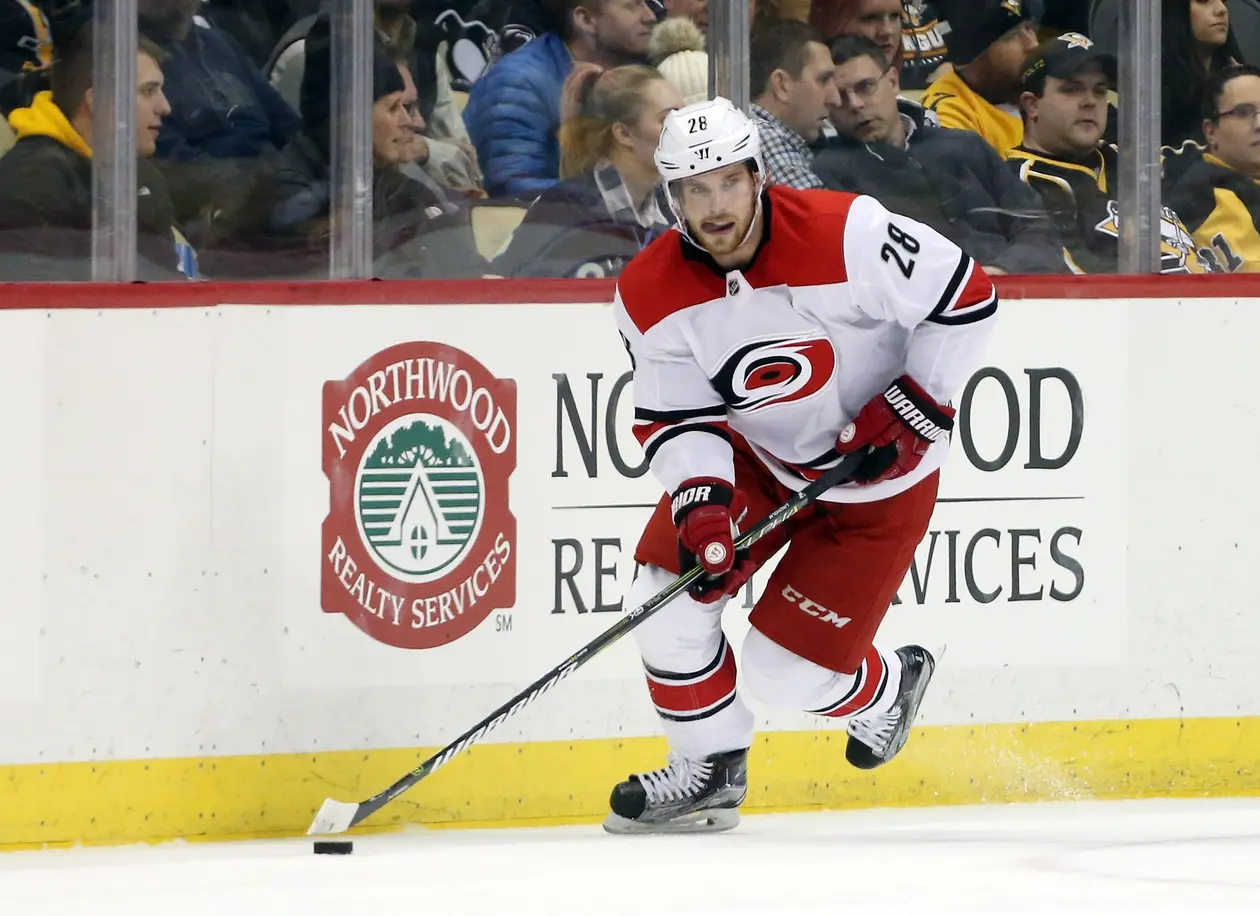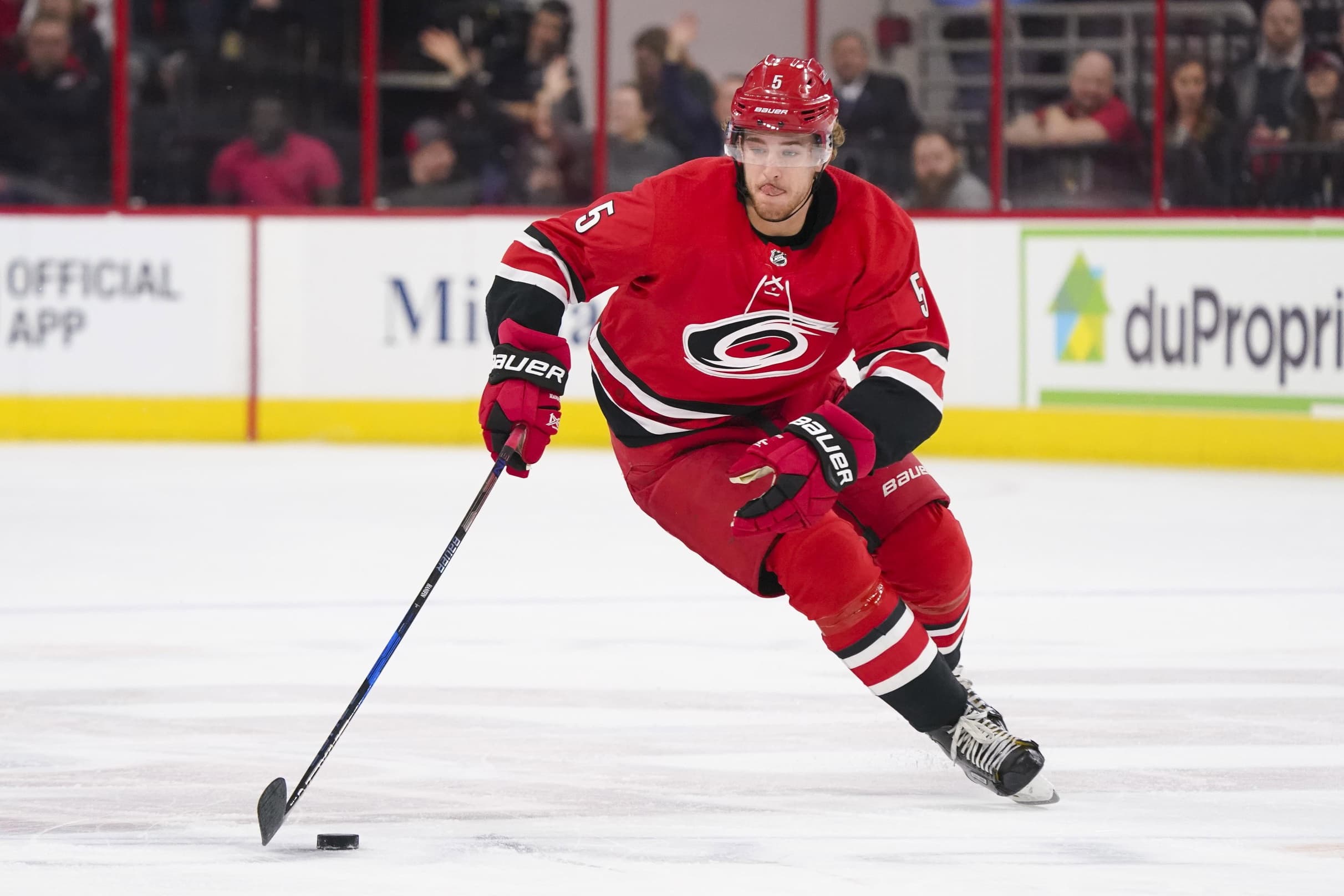Lindholm and Hanifin: Two different contract negotiations

Elias Lindholm and Noah Hanifin have a lot in common: they both came over from Carolina in the same deal, they’re both young, and they’re both restricted free agents. What separates them is that final parallel, though. While both Lindholm and Hanifin need contracts, there’s a decent chance their new deals with the Flames will look significantly different.
At least for me, one player seems like a really good fit for a long-term deal (6-8 years) while the other seems more in line for a bridge contract of two or three years. I say this for a number of different reasons; age, experience, track record, and ceiling all factor in. Let’s take a closer look.
LONG-TERM: ELIAS LINDHOLM
Of the two, Lindholm seemed like the more ideal fit for a long-term deal upon being acquired from the Hurricanes a few weeks ago. Calgary management and Lindholm’s camp seem to be thinking the same way, too. General manager Brad Treliving gave an update on Lindholm’s contract proceedings late last week.
“We’re having good discussions on all fronts,” Treliving said Friday. “With Elias, in particular, we’re looking to do something long-term. He’s got an interest in doing something long-term. Now we’re just, sort of, working through that.”
From a Flames perspective, you can understand why this would be the plan of attack. At just 23, Lindholm already has five full NHL seasons under his belt and has been remarkably consistent, especially since his rookie campaign.
As such, Calgary should have a pretty good idea of Lindholm’s baseline over a longer period of time. Take a look at how steady his offensive totals and scoring rates (all strengths) have been over the last four seasons. Scoring rates courtesy Natural Stat Trick.
| Season | G | A | PTS | G60 | A60 | P60 |
| 2014-15 | 17 | 22 | 39 | 0.77 | 0.99 | 1.76 |
| 2015-16 | 11 | 28 | 39 | 0.44 | 1.13 | 1.58 |
| 2016-17 | 11 | 34 | 45 | 0.50 | 1.56 | 2.06 |
| 2017-18 | 16 | 28 | 44 | 0.66 | 1.16 | 1.82 |
For Lindholm to have four seasons of consistent production like above is notable. We’re not talking about incredible production, but he’s now a proven 40-point player. Lindholm has done all this prior to his 24th birthday (that happens in December), which leads me to believe totals like this are the least we can expect over the next five or more years.
Knowing this, it’s hard to argue definitively against a long-term deal for Lindholm. The case gets made better when you think about the potential for more offence on a new team. In Johnny Gaudreau and Sean Monahan, Lindholm has the chance to play with the most dynamic linemates to date in his career. That could make his eventual AAV look pretty good on a long-term deal.
Lindholm’s consistency carries over when you dive into his underlying statistics, too. Much like his counting totals and scoring rates, Lindholm’s possession metrics have been steady and strong over his last four seasons in Carolina.
| Season | CF% | OZS% |
| 2014-15 | 53.4 | 56.6 |
| 2015-16 | 53.5 | 54.2 |
| 2016-17 | 52.2 | 50.2 |
| 2017-18 | 53.3 | 56.9 |
While sure things don’t exist, Lindholm is one of the safer bets I can remember for a long-term deal in a while. At worst, the Flames have a player good for a point every other game for the foreseeable future, while potential exists for a jump to a new offensive plateau.
Lindholm needs two more seasons to be eligible for unrestricted free agency, which is a big factor in this discussion. Knowing every UFA year bought typically raises a contract’s AAV incrementally, six years seems like the sweet spot. Calgary gets four UFA years, which is reasonable, and Lindholm gets security. Six years and $30 million feels like a decent ballpark.
BRIDGE: NOAH HANIFIN

Compared to Lindholm, Hanifin is far more of an unknown quantity, which is why a shorter term seems like the way to go. At 21, we’re talking about a younger player with far less of a consistent track record in his three NHL seasons. Hanifin’s ceiling is high and he’s improved each and every year, which is promising, but where he ends up plateauing still involves a little guesswork.
The biggest positive about Hanifin’s game is how much better he’s gotten each season. He’s gone from being a protected rookie to an impressive possession defenceman in his most recent campaign. Hanifin has yet to see top pairing matchups and has only one season of playing true top four minutes, but he’s also made significant steps year over year.
| Season | CF% | OZS% | TOI/G | ES TOI |
| 2015-16 | 49.8 | 54.9 | 17:54 | 15:27 |
| 2016-17 | 50.9 | 61.1 | 17:55 | 15:51 |
| 2017-18 | 56.2 | 62.8 | 18:52 | 16:59 |
Much like his usage and underlying metrics, Hanifin has gotten better offensively for three straight seasons, too. Shown below are Hanifin’s counting totals and scoring rates at all strengths.
| Season | G | A | PTS | G60 | A60 | P60 |
| 2015-16 | 4 | 18 | 22 | 0.17 | 0.76 | 0.93 |
| 2016-17 | 4 | 25 | 29 | 0.17 | 1.03 | 1.20 |
| 2017-18 | 10 | 22 | 32 | 0.40 | 0.89 | 1.29 |
The biggest question, and thus largest unknown, with Hanifin is when he levels off. Right now, his progression chart is very much on the up and up, which is how it should be at his age. If it doesn’t level off for another five years, Calgary will be laughing because we’ll be talking about a top tier blueliner. If he hits his plateau next year, though, it’s a different story, and you just never know when that development curve flattens out.
That’s why a bridge deal of three years makes the most sense, at least for me. A three-year term keeps Hanifin a restricted free agent at its conclusion in 2021 (he’s UFA eligible in July 2022), which keeps him a controllable asset for the team. If he keeps getting better then, yes, he’ll be due for a big raise, but that’s a “problem” the team would like to have.
I would imagine Hanifin’s camp would be on board with this line of thinking, too. Because his ceiling is so high, why wouldn’t Hanifin want to bet on himself to possibly land a big money deal on his third deal? While being prudent for the team, bridge deals always have the chance to pay off for the player, too.
A $3.5 million cap hit on a three-year deal seems realistic and fair for both sides, give or take a few hundred thousand on either side. It gives the team flexibility in the immediacy and guards against an early plateau while also giving the player plenty of incentive looking ahead to his next deal.
ARTICLE BROUGHT TO YOU BY SPORTS EXCELLENCE

Founded in 1950, Sports Excellence Corporation represents over 150 family-owned independent hockey retailers across Canada and the United States. Our highly knowledgeable hockey specialists are available to assist all your equipment needs. Find your closest Sports Excellence retailer here: Find a location near you!
Recent articles from Pat Steinberg





